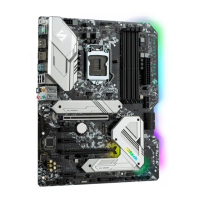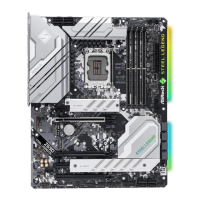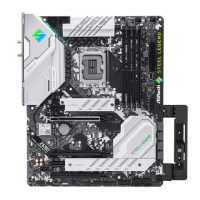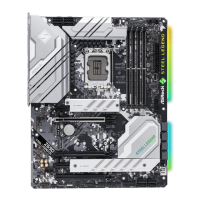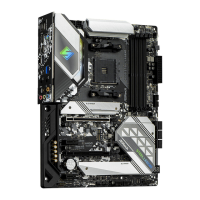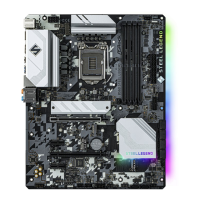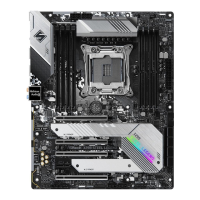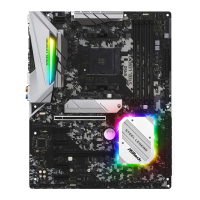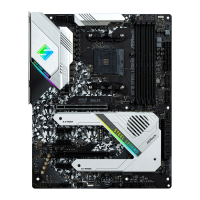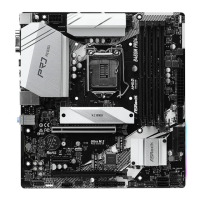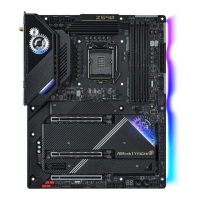
Do you have a question about the ASROCK Z590 Steel Legend and is the answer not in the manual?
| Processor socket | LGA 1200 (Socket H5) |
|---|---|
| Processor manufacturer | Intel |
| Compatible processor series | Intel Celeron, Intel Core i3, Intel Core i5, Intel Core i7, Intel Core i9, Intel Pentium |
| Non-ECC | Yes |
| Memory channels | Dual-channel |
| Memory slots type | DIMM |
| Number of memory slots | 4 |
| Supported memory types | DDR4-SDRAM |
| Maximum internal memory | 128 GB |
| Supported memory clock speeds | 4666, 4800 MHz |
| Supported storage drive interfaces | M.2, SATA III |
| Parallel processing technology support | - |
| USB 2.0 connectors | 2 |
| Number of SATA II connectors | 0 |
| Number of SATA III connectors | 6 |
| USB 3.2 Gen 2 (3.1 Gen 2) connectors | 1 |
| USB 2.0 ports quantity | USB 2.0 ports have a data transmission speed of 480 Mbps, and are backwards compatible with USB 1.1 ports. You can connect all kinds of peripheral devices to them. |
| Wi-Fi | No |
| LAN controller | Dragon RTL8125BG |
| Ethernet interface type | 2.5 Gigabit Ethernet |
| Component for | PC |
| Motherboard chipset | Intel Z590 |
| Audio output channels | 7.1 channels |
| Motherboard form factor | ATX |
| PCI Express x1 (Gen 3.x) slots | 3 |
| BIOS type | UEFI AMI |
| ACPI version | 6.0 |
| System Management BIOS (SMBIOS) version | 2.7 |
| Cables included | SATA |
| Harmonized System (HS) code | 84733020 |
| Weight | 1000 g |
| Depth | 244 mm |
|---|---|
| Width | 305 mm |
| Height | 70 mm |
Lists all items included in the motherboard package.
Details the hardware specifications of the motherboard.
Visual guide to the motherboard components and connectors.
Describes the ports and connectors on the rear I/O panel.
Instructions for installing the graphics card holder accessory.
Important safety and handling guidelines before installing components.
Step-by-step guide for installing the Central Processing Unit.
Instructions for mounting the CPU cooler assembly.
Guide on how to install RAM modules into the motherboard slots.
Details on using PCI Express slots for add-in cards.
Explanation and configuration of motherboard jumpers, including CMOS clear.
Identifies and explains system panel, power, and fan headers.
Describes the diagnostic LEDs for system boot status.
Guide for multi-GPU configurations with AMD graphics cards.
How to install M.2 Wi-Fi/Bluetooth modules.
Guide for installing M.2 NVMe SSDs in the Hyper M.2 slot.
Guide for installing M.2 SATA SSDs in the Ultra M.2 slot.
Guide for installing M.2 SATA/NVMe SSDs in another Ultra M.2 slot.
How to install essential motherboard drivers from the support CD.
Guide to ASRock's system management and tuning software.
Using ASRock's online store for software and updates.
Using Nahimic software for enhanced audio performance.
Controlling RGB lighting effects with ASRock's utility.
Overview of the UEFI Setup Utility and how to access it.
Description of the simplified BIOS interface for quick system overview.
Accessing the comprehensive BIOS configuration options.
Overview of the initial screen displayed upon entering UEFI setup.
Settings for overclocking CPU, memory, and other system components.
Detailed system configuration settings.
Access to utility tools like Instant Flash and RAID installer.
Monitoring system temperatures, fan speeds, and voltages.
Setting system passwords and secure boot options.
Configuring boot order, fast boot, and other boot-related settings.
Options for saving changes, discarding, or loading default BIOS settings.

